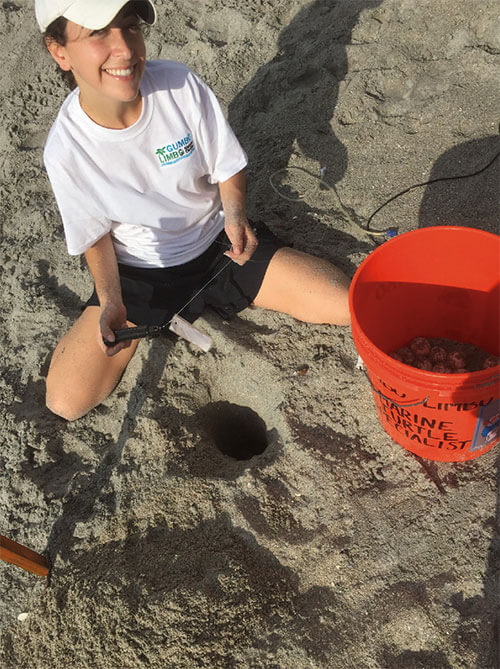Temperature-Dependent Sex Determination Unraveled: An Interview with Dr. Alex Lolavar
Larry Wood, Ph.D.
Dr. Lolavar is a recent graduate of Florida Atlantic University’s Integrative Biology Ph.D. program. Her research on sex determination in sea turtles has been critical to future conservation measures given the expected effects of climate change. She is now the Research Coordinator and an Affiliate Instructor in the Department of Educational Leadership and Research Methodology at FAU Hight School, located in Boca Raton, Florida. Her research was partially funded through a gift to FAU’s Graduate Program from the National Save The Sea Turtle Foundation.
Hi Alex! Congratulations on your Ph.D.! How did you originally develop an interest in science?
Thank you, great to be here! Since I was very young, I have always been interested in learning new things about the world we live in. I have many memories of my father and I having long, in-depth discussions on different scientific topics, ranging from astronomy to animal behavior. Growing up, I was surrounded by different animals including cats, dogs, turtles, horses, hermit crabs, and many others. My childhood love of animals evolved into a desire to learn more and more about them and I quickly learned that science or research was how I could answer all these questions.
Were sea turtles always a passion, or just a good model organism for your research interests?
To be honest, I didn’t realize how amazing sea turtles are when I first began working with them. When I started working in Dr. Jeanette Wyneken’s lab as an undergraduate student, I really didn’t know much about them at all. However, I quickly realized what amazingly cool animals they are. Now, they are not just my study organism, but also a passion of mine for the rest of my life.
Temperature Dependent Sex Determination (TSD) may be something new to some of our readers, how does it work compared to genetic sex determination?

TSD is a fascinating mechanism used by some invertebrate and vertebrate species to determine sex. In organisms with Genetic Sex Determination (GSD), like humans, the sex of the developing embryo is determined by the sex chromosomes inherited by the parents. Many of us are familiar with the terms “XX” and “XY”, which signify the chromosomes that females and males have, respectively. The presence of these chromosomes triggers the complicated pathways and mechanisms that result in the embryo developing as a female or male. The overall process in TSD is similar to GSD with one major difference. In TSD, that initial trigger is not caused by sex chromosomes (because many of these organisms do not have them), but rather temperature. In organisms with TSD, sex is determined by the temperatures the embryo experiences during development.
Evolutionarily speaking, how long has TSD been around? What types of organisms demonstrate TSD?
Temperature dependent sex determination (TSD) has been around for ~300 million years and in turtles, co-evolved with genetic sex determination ~200 million years ago. TSD can be found in many reptiles, including some species of lizards and snakes, many turtle species, and all crocodilians. Many species of fish also demonstrate TSD. Interestingly, all of these different organisms have evolved TSD multiple independent times, meaning there does not seem to be direct evolutionary lineage that results in an organism with TSD. In the case of other vertebrate species, TSD has not been observed in birds nor mammals, but some amphibians possess both genetic sex determination and TSD. Several invertebrate species also demonstrate TSD, as well other forms of environmental sex determination including sex determination by photoperiod, pH, and nutrition.
In turtles, what adaptive advantages does TSD provide the species who demonstrate it, and why might sea turtles be among those?
The adaptive advantage of TSD still remains in question and there are several hypotheses for why a species would evolve this sex determining mechanism. The most prominent and well-studied idea is that TSD promotes differential fitness, which basically suggests that there are sex-specific fitness benefits and some developmental temperatures are better for one sex. However, even this well-studied hypothesis has its short-comings as slight impacts on fitness are not easy to detect in long-lived animals with TSD. Another reason for the presence of TSD could be the quasi-neutral hypothesis which suggests that TSD actually provides a disadvantage but one that is so slight that it persists in these organisms.
There are several potential reasons why sea turtles are among those species with TSD. TSD may be a more advantageous sex-determining strategy for organisms like sea turtles in which survival of early life stages is heavily affected by temperatures. Specifically, high temperatures can increase mortality of early stages like the embryonic stages. By increasing production of females at these temperatures, sea turtles may be buffering the negative effects of high temperatures on the population in the future. Other studies suggest that TSD is a better strategy when offspring inhabit “patchy” or spatially differing environments, such as beaches. Sea turtle nesting beaches can vary greatly in many different factors including weather and beach characteristics and developing sea turtle embryos incubate in fluctuating and variable conditions. For these reasons, TSD is likely a better approach for sex determination in sea turtles.
I’ve heard that alligator nests, for example, produce more males at higher temperatures while sea turtle nests produce more females. Are all turtles that demonstrate TSD like the sea turtles, or do some follow the alligator model? Is it known why these differences exist?
There are three different patterns of TSD. Sea turtles demonstrate TSD I-a which is defined by cooler temperatures producing more males and warmer temperatures producing more females, which is demonstrated by many turtle species. In organisms with TSD I-b, we see the opposite with cooler temperatures producing more females and warmer temperatures producing more males, which can be found in some turtle species as well as tuataras. Lastly, TSD II is characterized by females being produced at both low and high incubation temperatures, but predominantly males are produced at intermediate incubation temperatures. We observe TSD II in some turtle, lizard, and crocodilian species. It’s interesting that you mention alligators. Though some studies report them as having a female-male pattern (TSD I-b), other studies suggest that they in fact have a female-male-female pattern (TSD II) but experience an increase in mortality at higher temperatures.
Similar to other aspects of TSD, the reason for these different TSD patterns is still debatable. Different TSD patterns may exist because the fitness of one sex may be higher at certain temperatures and the fitness of the other sex may be lower or unaffected by temperature. Defining which pattern a species demonstrates can be tricky because of the effect of temperature on both mortality and sex ratios, such as the case of alligators. There is a theory that suggests that organisms may not differ in which TSD patterns they demonstrate, but instead their survival at different temperatures directs which TSD pattern we observe.
Based on this pattern of TSD, male fitness might be expected to be greater than female fitness under conditions that produce more male offspring; the converse might be true for female fitness or female fitness might be independent of temperature according to the Charnov–Bull model.
Could you explain the difference between the ‘pivotal temperature’ and the ‘transitional range of temperatures’ (TRT) in a turtle nest?
Both of these values help us describe the relationship between nest temperatures and sex ratios but they tell us different things. We can illustrate this relationship as a sigmoid or S-shaped curve. The transitional range of temperatures (TRT) is the range of temperatures that results in a mix of both sexes and where the sex ratio goes from all male to all female. The approximate midpoint of this range and the temperature that produces a 1:1 sex ratio is called the pivotal temperature. Both the pivotal temperature and TRT vary among species, populations, and even individuals. It is important to remember that both of these values are derived by incubating eggs at constant temperatures in the lab so they are not extremely accurate when applied to nests incubating naturally in the field.
What basic question did you seek to answer with your research, and how did you formulate your experimental design to answer it?
The basic question for my research is how does moisture influence sex determination in sea turtles? From past literature, we know that changes in nest moisture, usually from either periods of drought or rainfall, affect nest temperatures which then influence sex determination. I wanted to better understand how nest moisture affects sex determination beyond this effect on temperature. In order to do this, I used an experimental approach where I could control for different variables in the lab. Groups of eggs were incubated at different temperatures and one of three sand moistures that represented moisture conditions during years with drought, average conditions, or excessive rainfall.
Sea turtles are Federally protected species, how did you obtain authorization to conduct your research?
Most of my past research has involved relocating eggs and incubating them in the lab or another site on the nesting beach. Jeanette and I coordinate closely with FWC to obtain authorization to use these necessary methods in my research. There are certain guidelines and protocols that I always follow to ensure the safety of the eggs and turtles involved in my projects. Over the past several years, I have been able to demonstrate the success of these projects and my ability to relocate and incubate eggs safely.
Were you able to answer your question? What were your primary results?
The results of my study are very exciting and begin to shed light on this interesting question that I’ve been working on for several years now. The overall purpose of my research and this study was to determine if moisture conditions during incubation influence sex ratios beyond a temperature effect. This study identifies that loggerhead embryos respond to temperatures differently based on sand moisture while they incubate. Basically, eggs that incubate in moisture extremes, very dry or very wet, have a more rapid transition from one sex to another. Another way to describe these results is that the TRT (range of temperatures that produce all male to all female) is narrower for these embryos.

What new research questions may have arisen from your conclusions?
We still have a lot more to learn about how moisture conditions during incubation affect sex determination. My research has centered around the relationships in loggerhead sea turtles but I would like to branch out to other species that nest in Florida, such as leatherback and green sea turtles. Previous literature has shown us that these sea turtle species exhibit different temperature-sex ratio responses, primarily by demonstrating narrower TRTs compared to the loggerhead. The other big question on my mind is how moisture may affect development and sex determination on a molecular level. Identifying moisture’s effects on the mechanism of sex determination would help us better understand its role outside of any temperature effects.
How might your results be applied to ongoing sea turtle conservation concerns?
As sea turtle biologists and conservationists, one of the biggest concerns we have on our minds is the ongoing threat of climate change. A better understanding of moisture’s overall effects on sea turtle development and biology will provide us with more accurate predictions of current and future sex ratios. Besides increasing temperatures, another effect of climate change is shifts in our precipitation patterns. In Florida, we can expect decreases in annual precipitation and increases in both periods of drought and storm severity. This means that Florida nests may be incubating in either very dry or very wet conditions, which can affect how they respond to temperatures and, ultimately, hatchling sex ratios.
Publishing your work in a peer-reviewed journal is a big accomplishment! What advice would you give to a young person thinking about pursuing a degree and/or career in biological research?
The best advice I can give is what I’ve learned from sea turtles themselves: Be resilient! There can be plenty of trying or frustrating moments while pursuing a degree and/or career in biological research but it is important to push through these times.
Another piece of advice I would give is to embrace different opportunities and never hesitate to expand your network. Meeting new people and learning about their unique scientific backgrounds is how you learn new techniques or approaches which will ultimately make you a better researcher. Lastly, and likely most important, never forget why you entered this field in the first place. If you’re contemplating pursuing a career in biological research or you’ve already begun, it means you have an innate curiosity and passion for your field. Reminding yourself of why you chose this path makes the difficult times more bearable and the good times even better.
Helping Sea Turtles Survive for 38 Years
A NON-PROFIT ORGANIZATION
State of Florida Registration Number CH-2841 | Internal Revenue Code 501 (c) (3)
Web Design & Development by Web Expressions, LLC

